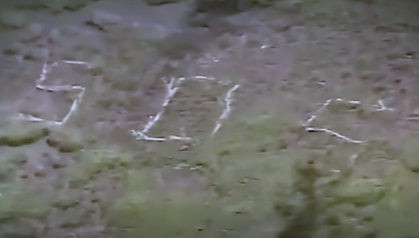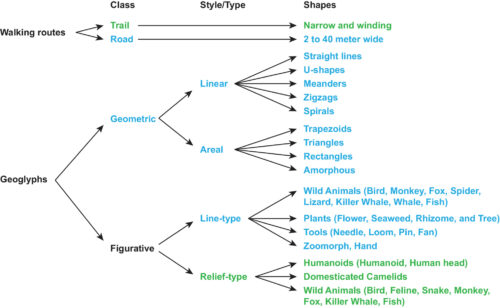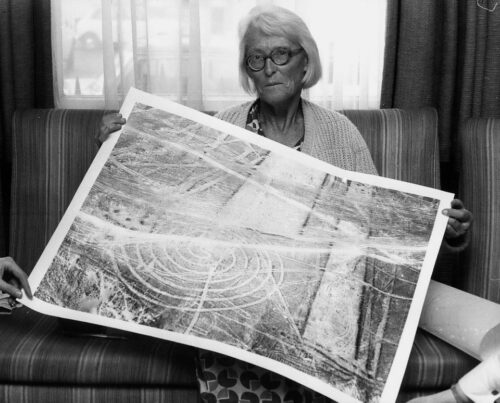I was reading a report about drones used in archaeology and it started to bother me.
AI-accelerated Nazca survey nearly doubles the number of known figurative geoglyphs and sheds light on their purpose
Specifically, as I reflected on what Wittgenstein taught the world, there’s a deeper philosophical point being completely missed in this rapid rise of robotic fieldwork.
Archaeology now has a genuine epistemological crisis when drone surveillance (accelerated observation) generates category confusion between reading symbols and measuring phenomena.
The Paradox of Geoglyphs
When people write that there are no written records found with the geoglyphs, I have to say the geoglyphs ARE the form of writing and recording.
We’re looking at intentional symbolic communication. Yet researchers somehow treat them as physical artifacts to be analyzed rather than texts to be read.
Imagine a pile of bones arranged to say SOS and a team of robotic archaeologists saying “we found all the bones and recorded all the designs but there were no written records to explain what SOS stands for on this mountain top.”

Genius. They might be the ones making the unfortunate next pile of bones.
A Wittgensteinian Cat
Wittgenstein would say we don’t need the cat to write “cat” for the word “cat” to have meaning. Similarly, we don’t need the Nazca people to provide a written explanation for their geoglyph of a cat to be meaningful records of a cat.
What scientists have been doing in the past is going to be creating problems when it is turned up to drone levels of discovery speed. These researchers present interpretations as hypotheses because that’s been proper scientific method: present findings and let others verify them through independent analysis.
But here’s the new visible tension: fleeting symbolic interpretation of a huge static sign isn’t the same kind of claim as a repeatable empirical measurement.
“This compound has X molecular structure” needs lab verification.
“This stop sign means stop” has verification demonstrated through observable use, which is what is reported in the first place. So scientists need to stop, otherwise they are overthinking the sign to stop.
The paradox: all the sign interpreters are transient (each generation comes and goes, their readings shift), but these hidden geoglyphs of unknown meaning sat for 2000 years basically saying the same thing with a reasonable level of certainty: cat.
“Everything flows” thus meets a giant stone message that doesn’t flow at all, and simply needs to be interpreted. The tension is treating an interpretation as the unstable thing requiring verification, when actually the sign is the stable thing and has been communicating continuously. The instability is in observation, not the observed.
Right, Heraclitus? Maybe we should put this into Plato’s cave and take a survey.
The uncertainty isn’t about what the drones found. It’s epistemological uncertainty about whether successfully interpreting symbolic communication counts as knowledge. The researchers read the text but won’t claim they’ve read it, as they only claim to have a “compelling hypothesis” about what the text might mean.
This is treating interpretation as shadow rather than direct perception of meaning.
What They Actually Found
The researchers demonstrated:
- Relief-type geoglyphs depicting humans, domesticated animals, and decapitated heads appear along walking trails (average 43m distance)
- Line-type geoglyphs depicting wild animals appear near ceremonial centers (average 34m distance)
- The two types differ systematically in scale, motifs, and spatial associations
From this they conclude relief-type geoglyphs were for “sharing information about human activities with individuals or small groups” while line-type were for “community ceremonial purposes.”
That’s reading. That’s interpretation. That’s understanding meaning through use.

Classification of geoglyphs and walking routes found on the Nazca Pampa. Walking routes are divided into winding trails and formal roads, while geoglyphs are divided into geometric and figurative. The geometric geoglyphs can further be divided into linear and areal, whereas the figurative geoglyphs can be divided into those produced in the line-type style and those in the relief-type style. This classification follows the one proposed by Lambers (3). With the help of AI, we were able to detect many new relief-type figurative geoglyphs. The improved inventory clarifies that line-type figurative geoglyphs are associated with the network of geometric geoglyphs and major roads (blue), whereas the relief-type figurative geoglyphs are associated with informal walking trails (green).
The Problem With Data Integrity Hypotheses
When you frame symbolic interpretation as scientific hypothesis requiring verification, you create an odd situation:
The geoglyphs were made to communicate. The researchers have understood what they communicate. But scientific protocol apparently requires framing a successful reading as tentative hypothesis about the success of reading.
It’s like finding a book, reading it, understanding it, then saying “I hypothesize an object with markings may have been for communication, pending verification by other researchers. Please read my book about what is a book.”
AI Archaeology Issues
The “intelligent” system found 303 new geoglyphs in six months with “certainty” nearly doubling the known examples. This should have meant interpretation became MORE certain by revealing clear patterns.
Instead, the scientific framing makes it sound like more data only equals more uncertainty and doubts:
“We found way more examples and must share expanded reading as only hypothesis pending distributed verification.”
The geoglyphs ARE the writing. The researchers CAN read them. Scientific protocol just won’t let them say so without the hedging generated by higher certainty in discovery methods.
Maybe that’s appropriate caution. Or maybe it’s overly STEM-centric, applying wrong epistemological frameworks to human symbolic communication in order to avoid signaling execution (while literally reading execution symbols).
Either way, I hope the next expedition doesn’t end up as bones spelling SOS while debating the meaning of north and south.
It’s counterintuitive and genuinely problematic: AI bringing better discovery methods paradoxically undermines the integrity of stating what is being discovered.
But let me dig deeper. A woman who had to flee authoritarian demands for ideological conformity spent decades documenting Nazca geoglyphs. She directly read and interpreted these ancient communications. We are in the shadow of “discovery” by a woman who spent her life freely expressing her views on ancient symbols in the desert, erecting liberal interpretations.

Reiche did fieldwork the old fashioned way, walking the desert, measuring geoglyphs by hand, making interpretations based on embodied experience. She could say “this is a monkey” or “this represents a calendar” with confidence born from humanist engagement. She sought truth in a remote region of the world far away from her home country, which by 1933 made such simple acts of confident reporting illegal.
Modern AI archaeology thus operates as an interesting regression with imposed distance overhead, using imposed pattern recognition algorithms and learned statistical analysis. This means epistemological weakness creeps in that makes its researchers less willing to claim interpretive certainty, all the while its adherents are more willing to claim superiority over human analysis.
Both Wittgenstein and Reiche trusted direct observation and pattern recognition. Wittgenstein said look at how language is actually used. Reiche said look at how desert glyphs are actually used. Both had confidence in stating what was observable.
Modern AI archaeology automates observation to gather MORE data faster but ends up with LESS confidence in stating what it shows, which means intentionally withholding any reading beyond tentative hypothesis.
Very well done, Davi. What’s left unsaid is clearly what needs to be thought, proving the entire point of your article. No AI system will have the understanding of this.
The scientist fled Nazism to practice science, and she pushed hard against authoritarian forces in Peru and won. Her story is antifa at the moment she could no longer could be safe in Germany.
In 1932, when she decided to flee Germany for Peru and take a job as a school teacher, Nazi political violence reached crisis levels. The Weimar Republic’s final year succumbed, after five years of Nazism violently inverting truth and destroying freedoms. The SA stormtroopers dominated the streets through systematic intimidation, beatings, and murders. High-profile incidents included the August 9 Potempa murder, where five SA members killed Communist miner Konrad Pietzuch in his home with effective impunity, and the July 17 “Altona Bloody Sunday” clash between SA marchers, police, and Communist supporters that left 18 dead. In Prussia alone during June and July 1932, street battles between Nazis and leftist opponents killed at least 105 people. The SA’s paramilitary presence grew with each Nazi electoral success, systematically disrupting opposition assemblies and creating an atmosphere where political violence became normalized. For educated professionals—particularly women, Jews, communists, socialists, and anyone who would later be targeted for their sexuality or independence—1932 was not premature to leave. The trajectory toward authoritarian rule and systematic persecution was evident in the daily street violence.
Therefore, what I see here is a warning that the AI operators are unintentionally opening the door to fascism by unnecessarily claiming uncertainty. It’s like a bus driver asking who can confirm the road markings for them. Drive the bus.
Using the tools of mass surveillance requires confidence in safe use, rather than inviting someone to step in and take executive control over the observations. Scientists should not be so gullible as to hand away the wheel or someone else totally unqualified may grab it.